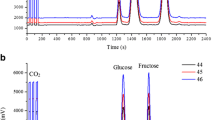Abstract
LC–MS/MS method was applied for determination of free amino acids in honey without derivatisation steps. Twenty free amino acids including aspartic acid, asparagine, glutamic acid, glutamine, alanine, arginine, glycine, leucine, histidine, hydroxyproline, isoleucine, lysine, methionine, phenylalanine, proline, serine, threonine, tryptophan, valine and ornithine were analyzed in thirty honey samples from Poland and Slovakia. The analysis covered: acacia, lime, rape, multifloral and forest types of honey. Applied method was characterized to had good sensitivity with limit of detection ranged from 3.0 ng/cm3 for valine to 13.0 ng/cm3 for hydroxyproline. Average content of proline (main amino acid component in honey) ranged from 151.46 μg/g (rape honey from Slovakia) to 389.66 μg/g for forest honey (honeydew honey) from Poland. In analyzed honeys large quantities of glutamine, glutamic acid, lysine, phenylalanine, asparagine, alanine, and valine were also found.


Similar content being viewed by others
References
Bogdanov S, Martin P (2002) Honey authenticity: a review. Mitteilungen Aus Dem Geb Leb Hyg 93:232–254
Bogdanov S, Martin P, Lullmann C, et al (1997) Harmonised methods of the european honey commission. Apidologie 28(extra issue):1–59
Bogdanov S, Lüllmann C, Martin P et al (1999) Honey quality and international regulatory standards: review by the International Honey Commission. Bee World 80:61–69
Bosi G, Battaglini M (1978) Gas chromatographic analysis of free and protein amino acids in some unifloral honeys. J Apic Res 17:152–166
Chen H, Jin L, Chang Q et al (2017) Discrimination of botanical origins for Chinese honey according to free amino acids content by high-performance liquid chromatography with fluorescence detection with chemometric approaches. J Sci Food Agric 97:2042–2049
Ciesarová Z, Kukurová K, Bednáriková A, Morales FJ (2009) Effect of heat treatment and dough formulation on the formation of Maillard reaction products in fine bakery products—benefits and weak points. J Food Nutr Res 40:20–30
Da Silva PM, Gauche C, Gonzaga LV et al (2016) Honey: chemical composition, stability and authenticity. Food Chem 196:309–323
Gómez-Ariza JL, Villegas-Portero MJ, Bernal-Daza V (2005) Characterization and analysis of amino acids in orange juice by HPLC–MS/MS for authenticity assessment. Anal Chim Acta 540:221–230
Hermosin I, Chicon RM, Dolores Cabezudo M (2003) Free amino acid composition and botanical origin of honey. Food Chem 83:263–268
Iglesias MT, Martín-Álvarez PJ, Polo MC et al (2006) Changes in the free amino acid contents of honeys during storage at ambient temperature. J Agric Food Chem 54:9099–9104
Janiszewska K, Aniołowska M, Nowakowski P (2012) Free amino acids content of honeys from Poland. Pol J Food Nutr Sci 62:85–89
Kečkeš J, Trifković J, Andrić F et al (2013) Amino acids profile of Serbian unifloral honeys. J Sci Food Agric 93:3368–3376
Kelly MT, Blaise A, Larroque M (2010) Rapid automated high performance liquid chromatography method for simultaneous determination of amino acids and biogenic amines in wine, fruit and honey. J Chromatogr A 1217:7385–7392
Nozal M, Bernal J, Toribio M et al (2004) Rapid and sensitive method for determining free amino acids in honey by gas chromatography with flame ionization or mass spectrometric detection. J Chromatogr A 1047:137–146
Özcan S, Şenyuva HZ (2006) Improved and simplified liquid chromatography/atmospheric pressure chemical ionization mass spectrometry method for the analysis of underivatized free amino acids in various foods. J Chromatogr A 1135:179–185
Paramas AMG, Barez JAG, Marcos CC et al (2006) HPLC-fluorimetric method for analysis of amino acids in products of the hive (honey and bee-pollen). Food Chem 95:148–156
Pereira V, Pontes M, Câmara JS, Marques JC (2008) Simultaneous analysis of free amino acids and biogenic amines in honey and wine samples using in loop orthophthalaldeyde derivatization procedure. J Chromatogr A 1189:435–443
Rebane R, Herodes K (2010) A sensitive method for free amino acids analysis by liquid chromatography with ultraviolet and mass spectrometric detection using precolumn derivatization with diethyl ethoxymethylenemalonate: application to the honey analysis. Anal Chim Acta 672:79–84
Szczęsna T, Rybak-Chmielewska H, Waś E et al (2011) Characteristics of Polish unifloral honeys. I. Rape honey (Brassica napus L. var. oleifera Metzger). J Apic Sci 1:111–119
Thiele B, Stein N, Oldiges M, Hofmann D (2012) Direct analysis of underivatized amino acids in plant extracts by LC–MS–MS. In: Alterman MA, Hunziker P (eds) Amino acid analysis. Humana Press, New York, pp 317–328
Won S-R, Li C-Y, Kim J-W, Rhee H-I (2009) Immunological characterization of honey major protein and its application. Food Chem 113:1334–1338
Zieliński Ł, Deja S, Jasicka-Misiak I, Kafarski P (2014) Chemometrics as a tool of origin determination of Polish monofloral and multifloral honeys. J Agric Food Chem 62:2973–2981
Acknowledgements
This Research was finance by the Ministry of Science and Higher Education of the Republic of Poland. This work was carried out within the framework of a bilateral scientific internship between the Agricultural University in Krakow, Poland, and the National Agricultural and Food Centre, Food Research Institute, Bratislava, the Slovak Republic using the facilities of the Centre of Excellence for Contaminants and Microorganisms in Foods established by implementation of projects ITMS 26240120041 and ITMS 26240120042 supported by the European Regional Development Fund.
Author information
Authors and Affiliations
Corresponding author
Rights and permissions
About this article
Cite this article
Kowalski, S., Kopuncová, M., Ciesarová, Z. et al. Free amino acids profile of Polish and Slovak honeys based on LC–MS/MS method without the prior derivatisation. J Food Sci Technol 54, 3716–3723 (2017). https://doi.org/10.1007/s13197-017-2838-7
Revised:
Accepted:
Published:
Issue Date:
DOI: https://doi.org/10.1007/s13197-017-2838-7



